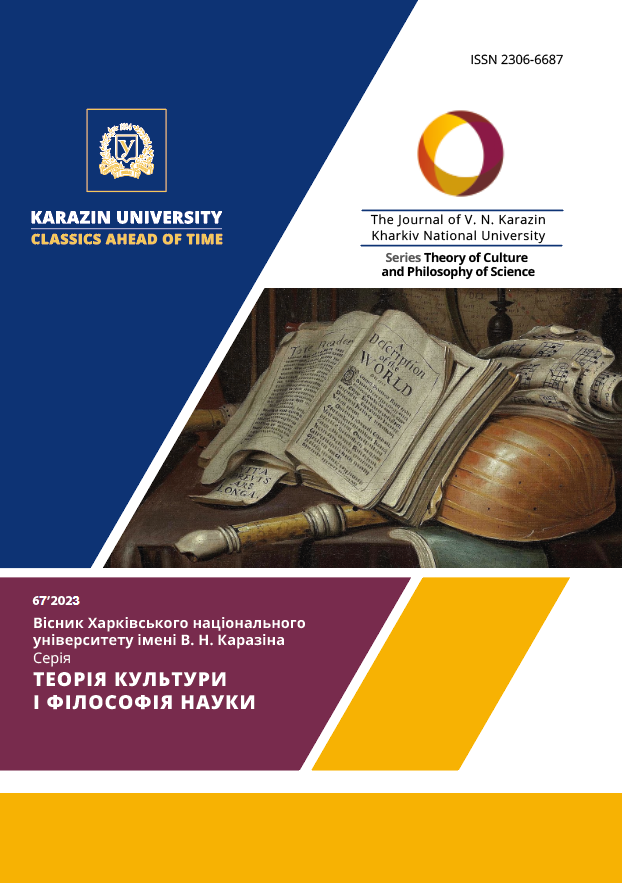VISUAL MEDIA INTHE CONTEXT OF ZYGMUNT BAUMAN'S THEORY OF «LIQUID MODERNITY»
Abstract
The article delves into the cultural-philosophical exploration of new visual media through Zygmunt Bauman's concept of «liquid modernity» (1925–2017), with a specific focus on the role of these media in shaping identity. The appeal of media is attributed to their pervasive presence in modern life, where smartphones are seen as extensions of the human body, and news feeds deliver a rapid, uncontrolled stream of photos and videos. Examining new media within the framework of liquid modernity can potentially reveal a significant correlation between these phenomena, complementing Bauman's concept of life strategies in this era.
The article outlines Bauman's key strategies in influencing contemporary identity, detailing the archetypes of the «pilgrim», the «vagabond», the «tourist», and the «player». It also explores the fundamental differences in theory between modernity and postmodernity, highlighting the criticisms Bauman has of liquid modernity, such as family crises, political impotence, chaos, inconsistency, rampant consumerism, and virtuality. Bauman's perspective on media appears predominantly pessimistic, viewing the virtual space primarily as an escape from reality.
Comparing the role of media in the concept of liquid modernity with seminal works in media theory (particularly the ideas of Marshall McLuhan and Friedrich Kittler) underscores the need to integrate media studies into Bauman's philosophy for a more profound understanding of identity construction principles in modernity. Analyzing McLuhan's approach to defining and analyzing media reveals that comprehending the societal and cultural changes brought about by emerging new media, which themselves convey messages, is crucial for understanding identity construction methods. McLuhan posits that the dominant culture type is shaped by the primary media of the era, suggesting that while printing led to a shift from audio-tactile to visual culture, the 20th century saw a resurgence of audio-tactile culture with the rise of new media.
To further explore media's role as a tool for manipulating reality, as emphasized by Bauman, we can turn to Susan Sontag's work. In her essay collection «Regarding the Pain of Others», Sontag analyzes the portrayal of violence in the media.
Downloads
References
Bauman, Z. Liquid Times: Living in an Age of Uncertainty. / Translated from English. Kyiv: "Krytyka," 2013. 176 p. (In Ukrainian)
Bauman, Z. Ethics in the Postmodern Era. / Translated from English by R. Zymovets, O. Yudin, D. Korol. Kyiv: Port-Royal, 2006. 329 p. (In Ukrainian)
Kіrіenko, O. Principles of Constructing Individual Identity in the Modern and Postmodern Eras: Zygmunt Bauman's Approach / Visnyk Lviv University. Series Philosophical-Political Studies. 2014. №5. Pp. 271–278. (In Ukrainian)
Petrenko, D. Philosophical Media Anthropology: Subject and Strategies / Bulletin of V.N. Karazin Kharkiv National University. Series "Theory of Culture and Philosophy of Science". № 52. Kharkiv, 2014. Pp. 128-133. (In Ukrainian)
Baudrillard, J. Simulacra and Simulation, Ann Arbor: University of Michigan Press, 1994. 164 р. (In English)
Ваuman, Z. From Pilgrim to Tourist – or a Short History of Identity / Questions of Cultural Identity. London, 2000. P. 18–35. (In English)
Benjamin, W. The Work of Art in the Age of Mechanical Reproduction, New York: Schocken Books, 1969. 26 р. (In English)
Czapnik S. An Interview with Zygmunt Bauman: How to Turn the Word into Fles / Sage Journals. 2017. URL:https://journals.sagepub.com/doi/full/10.1177/0263276417715312. (In English)
De Querol, R. Interview: Zygmunt Bauman: “Social media are a trap” / EL PAÍS. 2016. URL:https://english.elpais.com/elpais/2016/01/19/inenglish/1453208692_424660.html. (In English)
Kittler, F. Optische Medien, Berlin: Berliner Vorlesung 1999, 2002. 331 р. (In English)
Kittler, F. Gramophone, film, typewriter, Transl. from the germ. G. Winthrop, M. Wutz. Stanford: Stanford university press, 1999. 315 p. (In English)
Kittler, F. Perspective and the Book, Transl. from the germ. S. Ogger. Grey Room, Cambridge : Inc. and Massachusetts Institute of technology. 2001. № 5. P. 39-53. (In English)
Lyotard J.-F. The Postmodern Condition: A Report on Knowledge. Transl. from French by Benninton G., Massumi B. Manchester: Manchester University Press, 1984. 110 p. (In English)
McLuhan, M. The Gutenberg Galaxy: The Making of Typographic Man, Toronto: University of Toronto Press, 1962. 293 р. (In English)
McLuhan, M. Understanding Media: The Extensions of Man, Cambridge: The MIT Press, 1994. 389 р. (In English)
McLuhan, M. The Medium is the Massage, Berkeley: Gingko Press, 2001. 170 р. (In English)
McLuhan M. The Mechanical Bride: Folklore of Industrial Man, B.Y. : The Vanguard Press, 1951. 157 р. (In English)
Plecner, A. Interview with Zygmunt Bauman: Factors Which Made Holocaust Possible, Are Still With Us. Because We Are Still Modern / Communication Today. 2014. URL: https://communicationtoday.sk/interview-with-zygmunt-bauman-factors-which-made-holocaust-possible-are-still-with-us-because-we-are-still-modern/ (In English)
Sontag, S. Regarding the Pain of Others, N.Y.: PICADOR, 2003. – 103 с. (In English)
Wang, P. Recommendation Algorithm in TikTok: Strengths, Dilemmas, and Possible Directions / International Journal of Social Science Studies, 2022. URL:https://www.researchgate.net/publication/363416435_Recommendation_Algorithm_in_TikTok_Strengths_Dilemmas_and_Possible_Directions. (In English)




